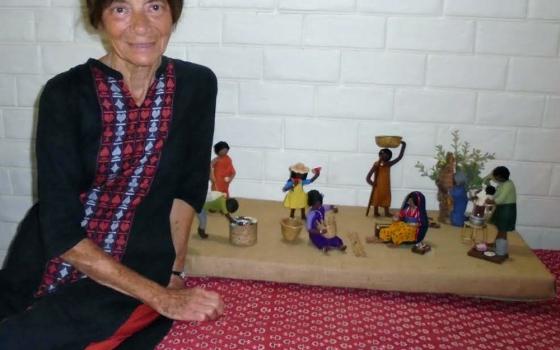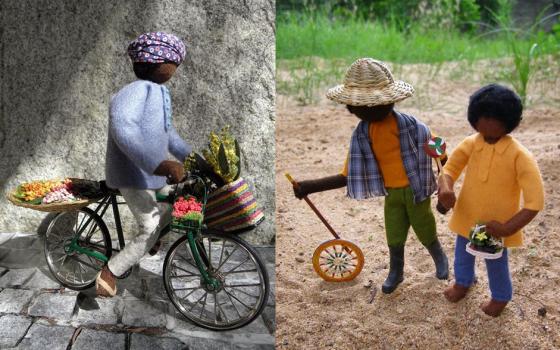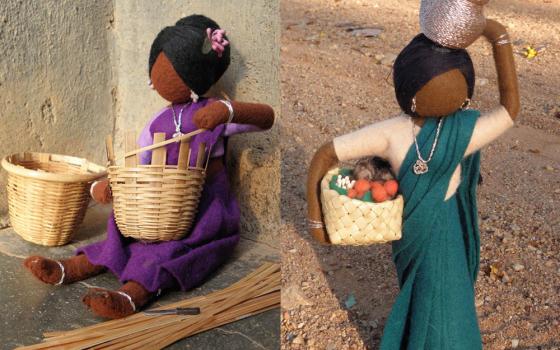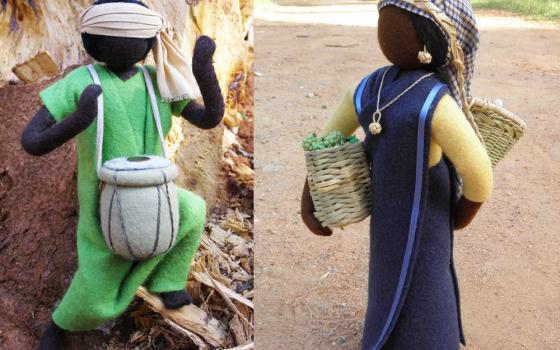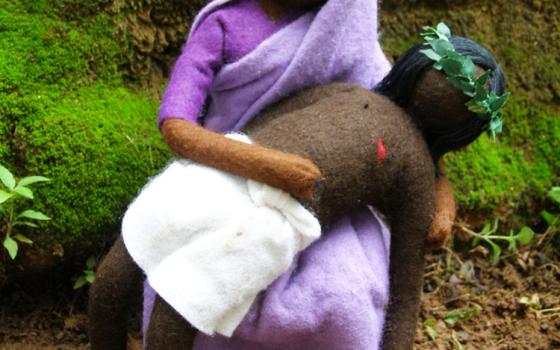Sr. Francoise Bosteels has been making dolls and exhibiting them for people regardless of their age, faith, language or color. The 74-year-old Belgian member of the Sisters of the Divine Savior says dolls can tell stories and spread messages of hope and values.
The stories of the sister's dolls are also about her encounter with the divine.
The Sisters of the Divine Savior (SDS) was founded in France in 1849. The congregation's charism relates to the mystery of Jesus' passion, death and resurrection, which in the context of day-to-day life means working among the crucified children of today, promoting justice, peace, dignity of all forms of life and respect for nature.*
Bosteels, who came to India in 1974 as a trained nurse, shared her unique mission with Global Sisters Report.
GSR: When did you start making dolls, and what prompted you to make them?
Bosteels: A serious illness threatened my life when I was 16. While confined to bed for several months, I started creating my own little dolls with the materials my mother gave me.
While struggling between life and death, I sensed the rhyme and rhythm of life streaming out from my heart into the dolls. Each became colorful and alive and evoked experiences and stories. They slowly grew into expressions of my playful imagination. A learning process commenced, unaware, through endless imaginations, intuitions and dreams within me. I could hear the cry, laughter, play of life in my dolls. In the womb of solitude, I felt the need for a profound self-surrender to the mystery of life.
Years later, I was called to live my religious life in rural India. The simple way of village life fascinated me — little girls leading sheep to pastures, women decking their tresses with buds, children fashioning playthings out of anything, men nurturing trees, the flower-man riding his bicycle, women carrying vegetables in handmade palm-leaf baskets or water in pots and jars, women learning to write their names or weave bamboo baskets, men ironing clothes in street corners or playing drums. My fascination translated into dolls. I worked during the calm and peaceful night. In the darkness of the night, I could see people's pain and celebration.
Please tell us about your life before becoming a nun.
I was born in 1942, during the Second World War, in a small, wealthy and welfare country, Belgium. I was brought up as one of the seven children by my loving parents.
My exposure to poverty and suffering raised disturbing questions. Is there a task to fulfill to lessen suffering, to enhance life? What is the origin, the purpose, the destiny of our life on Earth? Shouldn't we all be happy, sing, dance, tell stories and celebrate? Shouldn't we admire nature and all forms of life?
I came to know the Society of the Sisters of the Divine Savior during my nurse training course. The nuns' simplicity and dedication and their cordial relationship with patients appealed to me. I decided to join them in 1968, hoping to find answers to questions and reach out to people in need. It was the Gospel of Jesus that brought me to the SDS and, later, to India.
What did you do in India? How did you find life here?
India fascinated me with its beauty and rich and diverse culture and also its massive poverty. I joined my Indian sisters in Tamil Nadu [a southern Indian state] as a plunge into the unknown. We reflected a lot on the causes of poverty. We decided to live in villages and work with people rather than for people. We realized this would be possible only if we adopted a simple lifestyle and continuously search for answers with critical thinking. We chose a noninstitutional approach to religious life so that we could be more open to the Gospel challenges we face daily.
We engaged in preventive and curative health care, education and awareness-building. We support people's movements for justice. I worked in health education programs and in leprosy detection, prevention and care. Assisting in childbirth in huts and thatched houses with minimum facilities was also an avenue to teach people about hygiene, prevention of diseases and nutrition.
What I knew was Western medicine, but the people's ancient wisdom taught me a lot more. They knew the healing power of Mother Earth. The village life, people's closeness to nature and the beauty of their simple lives inspired me to make dolls. From 1984 to 2004, I was engaged in formation works in Bengaluru [then Bangalore, capital of Karnataka state]. Later, I joined the SDS provincial council. However, I continued my holistic health education through art and voluntary works among underprivileged children.
What did you do with the dolls?
The Indian experience, encouragement of friends and colleagues, and my own reflections provided meaning and purpose to the dolls' creation. They began to reflect Indian life — its breathtaking variety and its gripping and enduring tragedies.
The dolls present life of ordinary people. They give us deeper awareness of the excluded and despised. They tell us what it means to search daily for scraps to survive the next day, [to go] miles just to get a pot of water for your thirsty little daughter. They tell us about homeless people going nowhere. They tell us what it means to lose one's dignity, roots and identity, to lose land and jobs. They also tell us that these people are still resourceful and have vitality and can still struggle for dignity. They still hold on to values of sharing and compassion. They tell us about the beauty and love that throb beneath the ordinariness and boredom of their lives, and struggles for survival.
What has been the public reaction to the dolls?
During the exhibitions, people tell me God has spoken to them through the dolls. God challenges them. Dolls, like prophets of the old, speak sharply to the present generation. Many ponder over each doll and admit that their hearts are affected. The dolls challenge their perceptions and social values and practices. Hindus, Muslims, Christians, Sikhs or those with no faith say the dolls spring in their heart compassion and make them aware of their sinfulness. The dolls invade people's conscience with the truth embodied in and through them. Many have said the dolls speak a thousand words.
How are the dolls made? How much time do you take to make a doll?
The dolls and figurines are handmade using ordinary materials. They are a variety of colorful cloths: felt, raffia [strong paper ribbons], pipe cleaners, cotton balls for heads, wool, thread and discarded bobbins, banana and coconut fiber, palm leaves, bamboo, pieces of wood, small boxes and similar throwaway items. Gold and silver threads make a variety of jewelry. Sometimes I make use of small, ready-made toys or art pieces.
Initially, I took 11 to 13 hours to create a doll, not including the props that go with it. At present, I make dolls in seven to eight hours. I have made around 300 dolls in the past 37 years.
Has your congregation been supportive?
There were some difficulties initially, but my congregation and the Indian province have been very supportive and appreciative of my work. They have given me freedom and space to explore and express my creativity. They want the dolls to touch many more hearts.
How many exhibitions have you conducted?
Exhibitions have taken place in and outside India from 2000 in art galleries and academies, in colleges and universities, in private Christian schools.
Besides India, I have held exhibitions in Austria, Bolivia, the Philippines, Singapore, South Africa and Taiwan. I not only display dolls, but prepare write-ups on each doll to help people understand the message.
People of all walks of life ponder over the dolls and read poems and stories about them. At times, teachers ask students to analyze a poem or to write their own poem or story. Children interact and ask me to tell stories related to the dolls.
Have you conducted workshops to teach doll-making?
Four workshops were conducted in Bolivia for poor peasants and two in South Africa for communities facing social challenges like drug abuse and teenage pregnancy, the trauma of refugee flight from their home country at war, the impact of poverty on schoolgirls, and overcoming historical discrimination.
A workshop was organized in India for sex workers. During the workshop, women started sharing their stories and decided what issues to bring out through dolls made of local materials, rags and waste. They soon communicated their deepest self through the dolls they created. The body language of the dolls evoked a story of their lives. They became like people with lives of their own, expressing their sufferings which speak to our hearts. The stories translated into dolls, related to childhood experiences which forced women into prostitution, to the violence they have been subjected and the dignity they aspire for. Writing down the stories also helped women to articulate their experiences, their views and ultimate hope.
The doll-making process was a liberative experience because women discovered with a sense of pride their ability to create something they could admire, which also had a message to convey. The 80 dolls, narrating 10 touching life stories and the writings, were on display at the Christ University in Bangalore. The creators were there to interact with the viewers. This has given the women a sense of dignity and recognition.
Do people support you?
I have never planned publications, exhibitions or workshops. These happened because of people's initiative. The impact of dolls can be seen in the poems, prose and spiritual writings by some committed people. They say they have found meaning after watching the dolls.
These are found in my three publications: Through the Needle's Eye: Everyday Life of Everyday People, The Dolls Speak and Human Icons, Sacred Stories.
Many people have offered to contribute to what they call 'a humanitarian cause.' A beautiful example is the waiver of excess luggage granted by a few airlines when I travel to faraway places.
*An earlier version of this Q&A contained incorrect information about the Sisters of the Divine Savior.
[Philip Mathew is a journalist based in Bangalore, southern India. This article is part of an ongoing collaboration between GSR and Matters India, a news portal that focuses on religious and social issues.]
